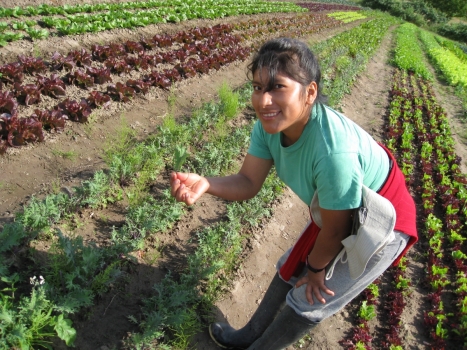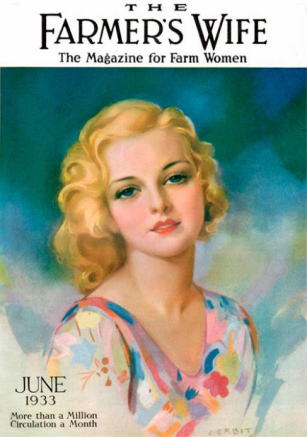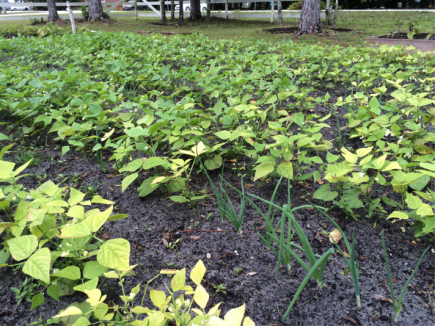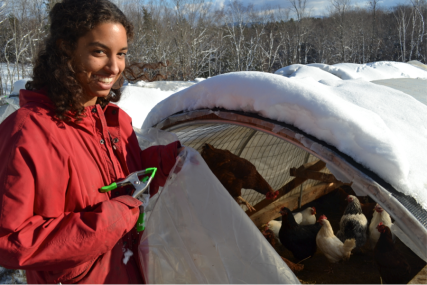By Allyssa Merwin
In the sphere of agriculture and farming a domestic and a public sphere has and continues to exist. This perpetuates the presence of one gender over the other. For the traditional American homestead, women were the leaders in the domestic sphere and the men were the leaders in the public sphere. Men historically and currently are the face of farming. If one were to go into a kindergarten classroom and ask the students what a farmer looks like, the overwhelming majority of children would describe someone along the lines of a tall white man in overalls (a stereotypical Old McDonald). However, agriculture is progressing in many ways, including gender roles. With climate change being a prevalent topic on the global minds of both agricultural producers and politicians alike, buzz words such as sustainable, subsistence, and resilience are now being tagged onto farming. How are we, the world, going to change farming practices to combat climate change and global warming while still feeding the projected 9.7 billion? Women all across the planet have stepped up and assumed these roles, yet the United States falls behind developing country. Why? The United States desperately need a next generation of farmers, younger adults have experienced barriers breaking into and staying a viable part of the farming industry. Those who experience these barriers the most are women, specifically women of color.
 Mesaproject.org
Mesaproject.org
Girls. We Run This – The Quick and Dirty History of European Women in American Agriculture:
For centuries, men have been the farmers and women the wives of farmers. Not until 1900 were women given a label on the farm and termed farmer’s wives or farm wife. These titles, though not always showing up on U.S Census information, are weighted with untold histories. This continued until the 1960s Women’s Rights movement and the creation of Women’s Studies higher education disciplines. Today’s farming landscape, no pun intended, is made up of women from all walks of life, with all different perspectives on the future of agriculture.
Women’s roles in agriculture in the United States of America are believed to begin with the first humans crossing the Pacific Ocean by either the Bering Straight or by boat from the western many islands. Native Americans created a culture of equality between gender roles where turns where taken in planting, growing, harvesting and finally collecting the seeds for the next season (Diamond, pg 138). Some archeologists will argue that this form of farming is not farming in a modern sense at all and just subsistence living. Though an argument I disagree with because it is highly Eurocentric, for argument’s sake and to move along, we will begin with the influx of European settlers in the British colonies of the Americas.
With the expansion of the British Empire in the colonies, the majority of people coming over to America and staying in the colonies were indentured servants. Of these indentured servants, most of them were men. When women did survive the three-month crossing of the Atlantic Ocean, because of their scarcity, if they were not indentured servants themselves, they were quickly married off. Once married, women were expected to help run the household, within the confines of their gender roles and domestic sphere (Zinn, pg 84). This help would range from anything from raising and caring the livestock and tending to the subsistence gardening. These activities would take place both in town limits, as well as in the wilds of the New World. Besides the disease, childbirth and the complications after was the biggest killer women had to battle. As European settlers expanded across the continent, women’s roles did not change vastly until the Industrial Revolution, as did the solidification of gender roles on the farm.
Before the Industrial Revolution, women were expected to fulfill certain roles, like caretaker, healer and mother. The sheer lack of European women in the colonies and frontier resulted in the sharing of roles and responsibilities throughout the rest of the homestead. Both men and women planted, maintained crops, and harvested at the end of the season. They canned food together, butchered and preserved animal meat together, all in the name of survival and rarely for profit (Lawrence, 2009).
When the Industrial Revolution took hold in the New World, the colonies had been their own sovereign nation for forty plus years. The point of the agricultural application of the Industrial Revolution was two pronged. Farming equipment was invented to help farmers compete for profit with larger plantations and also allow plantations to keep up with the work, as transporting new slaves from Africa was illegal in 1807 and beyond. Plantations fueled by cotton and sugar cane demand in Europe would have easily folded without the invention of machinery like Eli Whitney’s cotton gin. Men were driving cotton gins and plow systems and women were not expected to, thus gender roles on the farm were solidified. These roles were not challenged in open air until the 1960s with the Women’s Rights Movement.
 Farmerswifemagazine.com
Farmerswifemagazine.com
Before the Women’s Rights Movement, women born into the world of homesteading
and farming were expected to fulfill one role, a farmer’s wife and never a farmer. If they wanted to be anything else, they would have to seek education in the cities of the United States, typically in an area not directly associated with Agriculture. Farming and all things related were a man’s world and women would not and could not possibly be taken seriously in this arena. The Women’s Rights Movement helped open new doors for education and shared responsibilities for both men and women who were born into a farming family or those who sought out farming from other walks of life (Brasier, et all, 2014).
Sharon Steffens and Pat Cohill, members of Women for the Survival of Agriculture in Michigan recently penned their thoughts on women in agriculture pre-1960s:
“Beset with many serious problems, American Agriculture, as a fragmented industry, lacked a single voice through which to speak to bring about effective change. Many felt agriculture needed to develop a voice to speak for the entire industry. Women were to play an important role in developing a united voice for agriculture.”
The biggest victory for women in agriculture came with the Love v. Vilsack federal court case ruling. Filed back in October 2000, it took over 15 years for the women represented to prove that the United States Department of Agriculture took an active role in the discrimination against women in the agriculture industry in the form of denying them farm loans to begin or sustain their farming practice. The court ruling has allowed all women in the United States better access to resources need to get their feet of the ground.
Today, women are making history in the agricultural world. More women are leading in the research field as well as the fields. There are all women run organizations whose mission is specifically designed to support women in agriculture (see Farming Equity section). Minority women are gaining a voice in the agricultural world academically, politically and economically. It is good to be a woman farmer in 2015. However there are still hurdles to overcome. In 2007, women were operators of 30% of all the land designated as agricultural and 14% of all farmers were women who classified themselves as principle operators (typically both owners and operators). The 2012 census shows a decline in both areas by 1% and 4%, respectfully. Thought these look like major setbacks, the United States Department of Agriculture has created programs to cultivate opportunities in farming for women. These grants and programs directly target those most marginalized by American societies, not only women, but also women of color. Only time will tell if these programs will help boost economic growth for women farmers.
 Photo by the author
Photo by the author
Mind the Gap! Ending the Inequity of Women of Color in Agriculture and beyond:
There have been many victories for women and women in agriculture in the United States, but those who feel these victories the least are women of color. African American women especially have a difficult time embracing farming due to one major event that haunts the United States to this day, slavery. This mental reflex does occur primarily in the Deep South where racial undertones simmer just under the surface of daily life. The tendency to distance oneself from agriculture can also be found in children of immigrant farm workers.
The ghost of slavery and subhuman working conditions still found in the agricultural fields make those who are already marginalized American citizens find farming less than desirable. However, there are now community-led efforts finding footing in Southern societies of color, led primarily by women (Ammons, 2014).
 Blacklandproject.org
Blacklandproject.org
Food has always had its way of crossing social, economic, racial, and religious boundaries. The heritage of food in Southern culture, specifically African American and Hispanic culture, is by far the strongest in the United States. Tapping into that sense of self and identity, community-based organizations are bringing a resurgence of young women of color to Agriculture. Though these organizations are helping women of color create equitable and profitable careers in farming and agriculture, African American women trail Hispanic and White women farmers with just over 46,500 farms operated compared to 99,734and 288,264 respectfully. There is still along way to go to increase access and sustainability for all women.
Fighting the Good Fight- Who is Spearheading the Change for Farming Equity?
Though we are strong and independent, women cannot go it alone in the world of agriculture. Support systems off all shapes and sizes have been invented and have evolved to help women who have inherited farm ownership to those who are just starting out.
American Agri-Women is a large coalition of organizations supporting women in all areas of agriculture. There primary focus is on collective advocacy of women’s rights in agriculture. They are a national organization hoping to foster the next generation of women in all areas of farming, ranching and research.
Land Loss Protection, Inc is a grass roots organization based in North Carolina. These groups of lawyers focus on the prevention of the loss of land owned by famers of color through policy advocacy and legal technical assistance. Mainly supporting African American communities, Executive Director and founding member, Savi Horne describes the passion behind LLP’s mission here.
Center for Environmental Farming Systems (CEFS)
The Center for Environmental Farming Systems is a combined effort from North Carolina State University and North Carolina Agricultural & Technological State University. They focus on four primary areas: sustainability and heath, economic security, community engagement and extension and outreach. CEFS does this all through a racial equity lens in hope of prompting the next generation of farmers in marginalized communities emphasizing the growth of women of color in all sectors agricultural industries but specifically sustainable agriculture.
Farmworkers Association of Florida
Farmworkers Association of Florida is a prevailing non-profit organization that provides support and technical assistance for a number key issues migrant farm workers face in the fields and in their homes. In the realm of women, Farmworkers Association of Florida provides pre-partum and post partum help for farmworkers by partnering with free women’s health clinics who do not require U.S identification to be admitted. The ability for pregnant women and new mothers to seek medical care and support has vastly increased the mother and child’s overall health and well-being. In addition to the clinics, Farmworkers Association of Florida have partnered with The University of Central Florida and Blue Cross Blue Shield of Florida to track how the pregnant body coups with constant exposure to pesticides and what it does to the unborn child. This study has directly helped curb pesticide and herbicide usage and human exposure while in the greenhouses and fields of Florida.
National Women in Agriculture Association
The National Women in Agriculture Association is a fairly new organization that primarily focuses grass roots outreach programs design to strengthen women in agriculture as well as the diversity of American Agriculture. They support a wide variety of areas in agriculture. Some of the areas include urban agriculture, master gardener, nutrition and livestock rising.
What’s Next? – Conclusion:
In order for people to live, we must eat. In order for us to eat, we must grow food. By 2050 the world will reach 9.7 billion people and current agricultural practices and farmer populations will not be able to sustain such a large number. Opening the door for every one in the United States, and beyond, if they desire to be able to successfully be a part of the agricultural industry is key. Women all over the U.S. are breaking down barriers for fellow women and future generations to be a pivotal part of farming and agriculture. With pressure from organizations, key policies are being enacted to insure equity among all women in farming to have a fair chance at making a profitable and sustainable career.
Works Cited:
Brasier, Kathryn J., et al. “Capturing the Multiple and Shifting Identities of Farm Women in the Northeastern United States.” Rural Sociology 79.3 (2014): 283-309.
Brown, Minnie Miller. “Black Women in American Agriculture”. Agricultural History 50.1 (1976): 202–212.
Lawrence, Deborah. Writing the Trail: Five Women’s Frontier Narratives. Iowa City: University of Iowa Press, 2006;2009;.
Rotman Deborah. “Separate Spheres? Beyond the Dichotomies of Domesticity”. Current Anthropology, Vol. 47, No. 4 (August 2006), pp. 666-674
Zinn, Howard. A People’s History of the United States. 1st ed. New York: Harper & Row, 1980.